transmission oil NISSAN NV200 2016 Owners Manual
[x] Cancel search | Manufacturer: NISSAN, Model Year: 2016, Model line: NV200, Model: NISSAN NV200 2016Pages: 312, PDF Size: 6.65 MB
Page 17 of 312
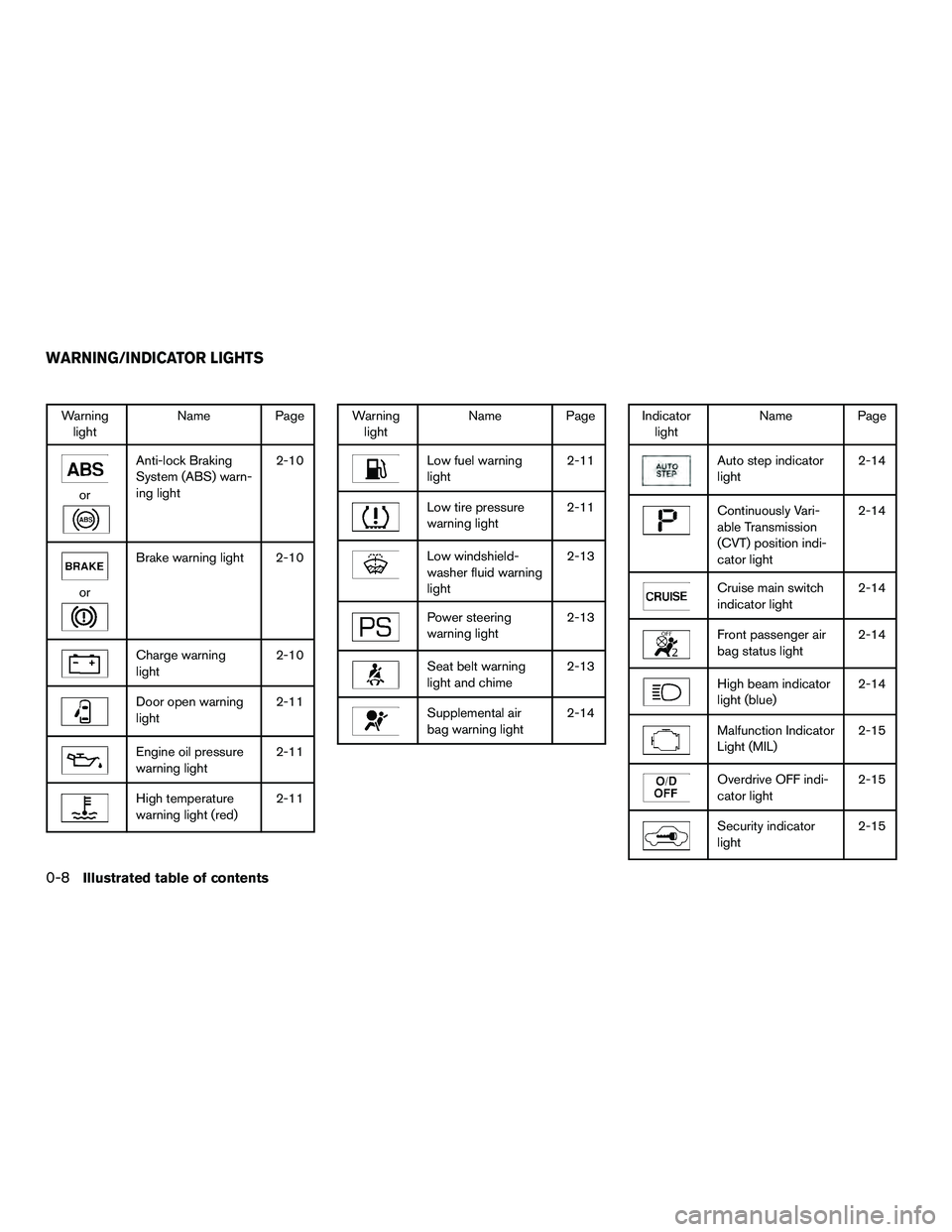
Warninglight Name Page
or
Anti-lock Braking
System (ABS) warn-
ing light 2-10
or
Brake warning light 2-10
Charge warning
light
2-10
Door open warning
light2-11
Engine oil pressure
warning light2-11
High temperature
warning light (red)2-11
Warning
light Name Page
Low fuel warning
light 2-11
Low tire pressure
warning light2-11
Low windshield-
washer fluid warning
light2-13
Power steering
warning light
2-13
Seat belt warning
light and chime2-13
Supplemental air
bag warning light2-14
Indicator
light Name Page
Auto step indicator
light 2-14
Continuously Vari-
able Transmission
(CVT) position indi-
cator light2-14
Cruise main switch
indicator light
2-14
Front passenger air
bag status light2-14
High beam indicator
light (blue)2-14
Malfunction Indicator
Light (MIL)2-15
Overdrive OFF indi-
cator light2-15
Security indicator
light2-15
WARNING/INDICATOR LIGHTS
0-8Illustrated table of contents
Page 88 of 312
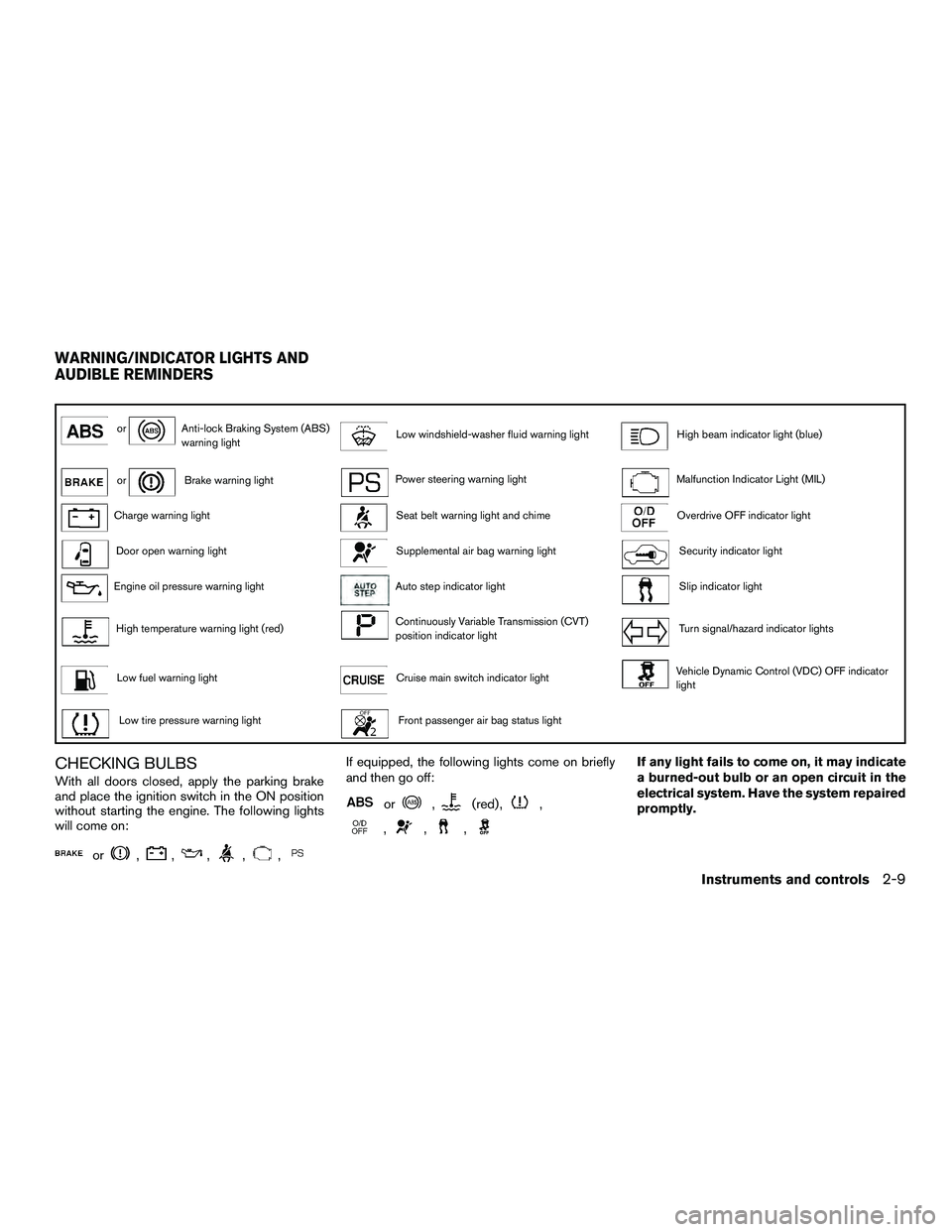
orAnti-lock Braking System (ABS)
warning lightLow windshield-washer fluid warning lightHigh beam indicator light (blue)
orBrake warning lightPower steering warning lightMalfunction Indicator Light (MIL)
Charge warning lightSeat belt warning light and chimeOverdrive OFF indicator light
Door open warning lightSupplemental air bag warning lightSecurity indicator light
Engine oil pressure warning lightAuto step indicator lightSlip indicator light
High temperature warning light (red)Continuously Variable Transmission (CVT)
position indicator lightTurn signal/hazard indicator lights
Low fuel warning lightCruise main switch indicator lightVehicle Dynamic Control (VDC) OFF indicator
light
Low tire pressure warning lightFront passenger air bag status light
CHECKING BULBS
With all doors closed, apply the parking brake
and place the ignition switch in the ON position
without starting the engine. The following lights
will come on:
or,,,,,
If equipped, the following lights come on briefly
and then go off:
or,(red) ,,
,,,
If any light fails to come on, it may indicate
a burned-out bulb or an open circuit in the
electrical system. Have the system repaired
promptly.
WARNING/INDICATOR LIGHTS AND
AUDIBLE REMINDERS
Instruments and controls2-9
Page 230 of 312
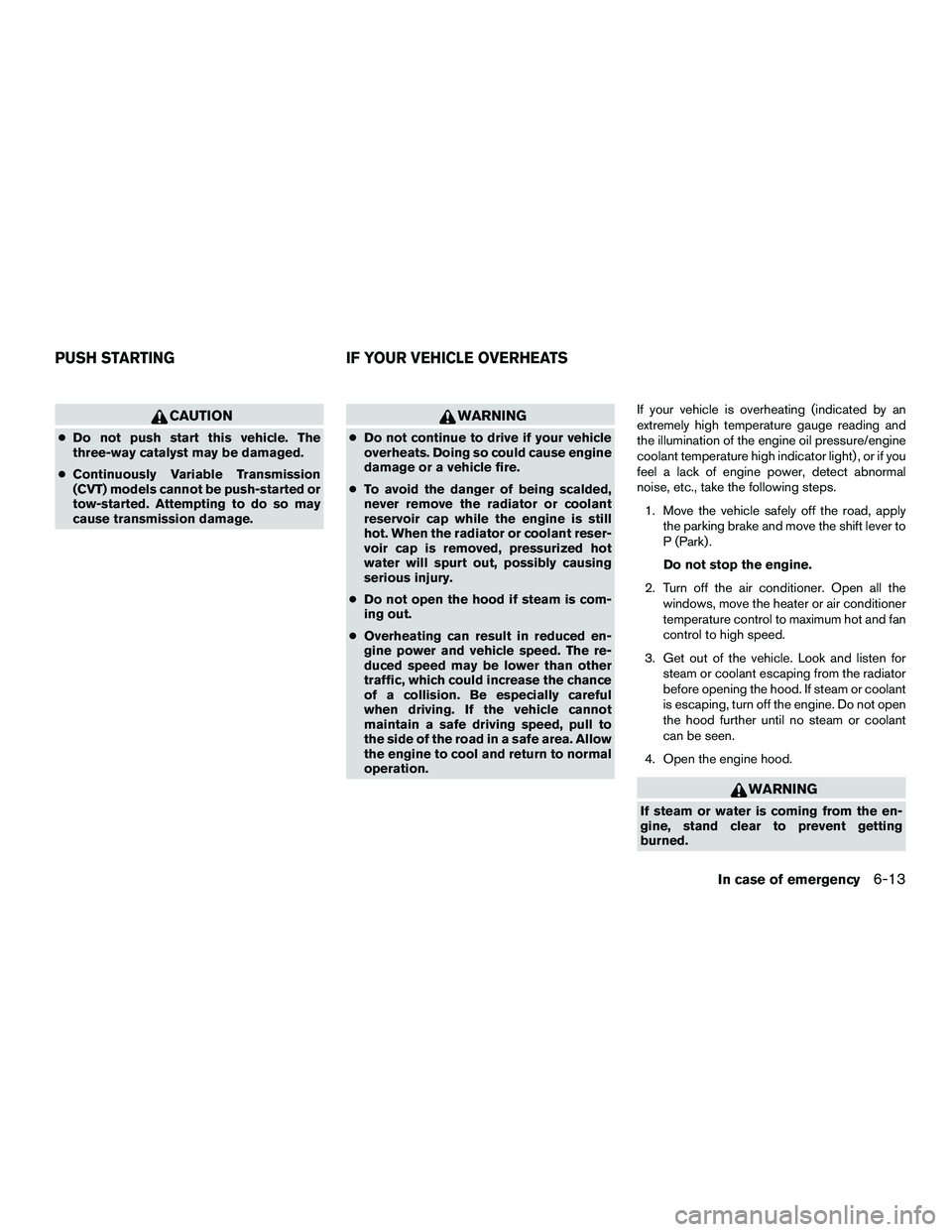
CAUTION
●Do not push start this vehicle. The
three-way catalyst may be damaged.
● Continuously Variable Transmission
(CVT) models cannot be push-started or
tow-started. Attempting to do so may
cause transmission damage.
WARNING
● Do not continue to drive if your vehicle
overheats. Doing so could cause engine
damage or a vehicle fire.
● To avoid the danger of being scalded,
never remove the radiator or coolant
reservoir cap while the engine is still
hot. When the radiator or coolant reser-
voir cap is removed, pressurized hot
water will spurt out, possibly causing
serious injury.
● Do not open the hood if steam is com-
ing out.
● Overheating can result in reduced en-
gine power and vehicle speed. The re-
duced speed may be lower than other
traffic, which could increase the chance
of a collision. Be especially careful
when driving. If the vehicle cannot
maintain a safe driving speed, pull to
the side of the road in a safe area. Allow
the engine to cool and return to normal
operation. If your vehicle is overheating (indicated by an
extremely high temperature gauge reading and
the illumination of the engine oil pressure/engine
coolant temperature high indicator light) , or if you
feel a lack of engine power, detect abnormal
noise, etc., take the following steps.
1. Move the vehicle safely off the road, apply the parking brake and move the shift lever to
P (Park) .
Do not stop the engine.
2. Turn off the air conditioner. Open all the windows, move the heater or air conditioner
temperature control to maximum hot and fan
control to high speed.
3. Get out of the vehicle. Look and listen for steam or coolant escaping from the radiator
before opening the hood. If steam or coolant
is escaping, turn off the engine. Do not open
the hood further until no steam or coolant
can be seen.
4. Open the engine hood.
WARNING
If steam or water is coming from the en-
gine, stand clear to prevent getting
burned.
PUSH STARTING IF YOUR VEHICLE OVERHEATS
In case of emergency6-13
Page 240 of 312
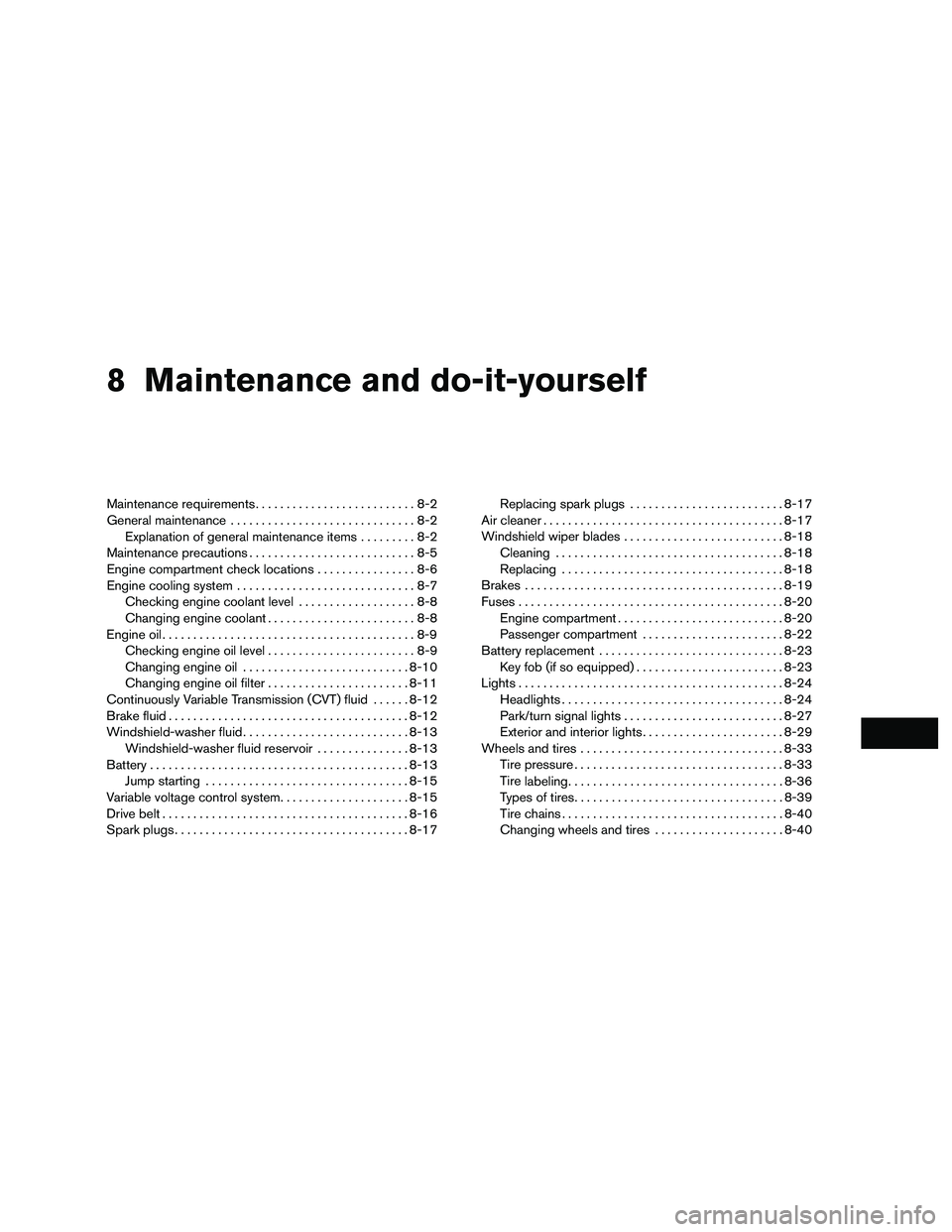
8 Maintenance and do-it-yourself
Maintenance requirements..........................8-2
General maintenance ..............................8-2
Explanation of general maintenance items .........8-2
Maintenance precautions ...........................8-5
Engine compartment check locations ................8-6
Engine cooling system .............................8-7
Checking engine coolant level ...................8-8
Changing engine coolant ........................8-8
Engine oil .........................................8-9
Checking engine oil level ........................8-9
Changing engine oil ........................... 8-10
Changing engine oil filter .......................8-11
Continuously Variable Transmission (CVT) fluid ......8-12
Brake fluid ....................................... 8-12
Windshield-washer fluid ........................... 8-13
Windshield-washer fluid reservoir ...............8-13
Battery .......................................... 8-13
Jump starting ................................. 8-15
Variable voltage control system .....................8-15
Drive belt ........................................ 8-16
Spark plugs ...................................... 8-17Replacing spark plugs
......................... 8-17
Air cleaner ....................................... 8-17
Windshield wiper blades .......................... 8-18
Cleaning ..................................... 8-18
Replacing .................................... 8-18
Brakes .......................................... 8-19
Fuses ........................................... 8-20
Engine compartment ........................... 8-20
Passenger compartment .......................8-22
Battery replacement .............................. 8-23
Key fob (if so equipped) ........................ 8-23
Lights ........................................... 8-24
Headlights .................................... 8-24
Park/turn signal lights .......................... 8-27
Exterior and interior lights .......................8-29
Wheels and tires ................................. 8-33
Tire pressure .................................. 8-33
Tire
labeling ................................... 8-36
Types of tires .................................. 8-39
Tire chains .................................... 8-40
Changing wheels and tires .....................8-40
Page 285 of 312
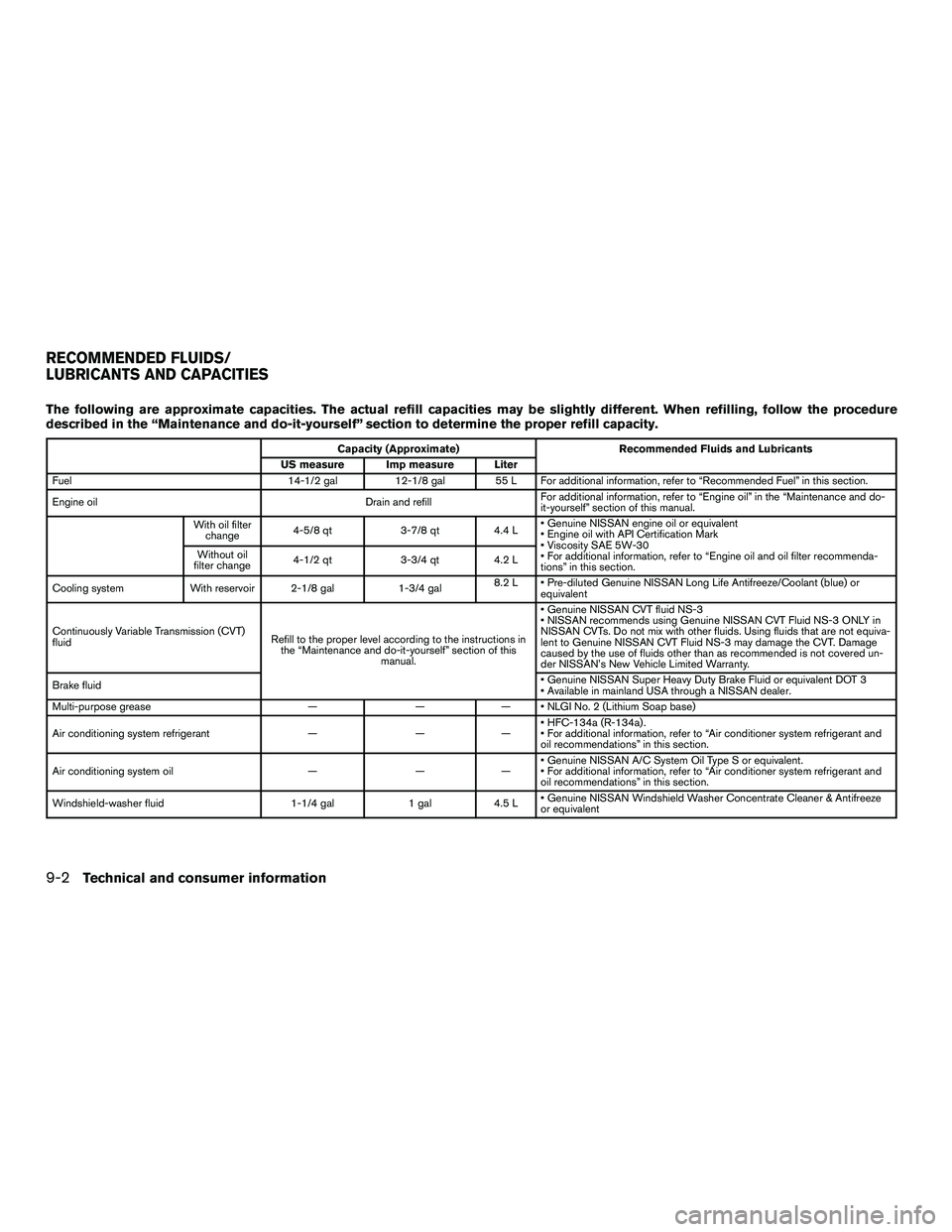
The following are approximate capacities. The actual refill capacities may be slightly different. When refilling, follow the procedure
described in the “Maintenance and do-it-yourself” section to determine the proper refill capacity.
Capacity (Approximate)Recommended Fluids and Lubricants
US measure Imp measure Liter
Fuel 14-1/2 gal12-1/8 gal 55 L For additional information, refer to “Recommended Fuel” in this section.
Engine oil Drain and refillFor additional information, refer to “Engine oil” in the “Maintenance and do-
it-yourself” section of this manual.
With oil filter change 4-5/8 qt
3-7/8 qt4.4 L• Genuine NISSAN engine oil or equivalent
• Engine oil with API Certification Mark
• Viscosity SAE 5W-30
• For additional information, refer to “Engine oil and oil filter recommenda-
tions” in this section.
Without oil
filter change 4-1/2 qt
3-3/4 qt4.2 L
Cooling system With reservoir 2-1/8 gal 1-3/4 gal8.2 L • Pre-diluted Genuine NISSAN Long Life Antifreeze/Coolant (blue) or
equivalent
Continuously Variable Transmission (CVT)
fluid Refill to the proper level according to the instructions in
the “Maintenance and do-it-yourself” section of this manual. • Genuine NISSAN CVT fluid NS-3
• NISSAN recommends using Genuine NISSAN CVT Fluid NS-3 ONLY in
NISSAN CVTs. Do not mix with other fluids. Using fluids that are not equiva-
lent to Genuine NISSAN CVT Fluid NS-3 may damage the CVT. Damage
caused by the use of fluids other than as recommended is not covered un-
der NISSAN’s New Vehicle Limited Warranty.
Brake fluid • Genuine NISSAN Super Heavy Duty Brake Fluid or equivalent DOT 3
• Available in mainland USA through a NISSAN dealer.
Multi-purpose grease ——— • NLGI No. 2 (Lithium Soap base)
Air conditioning system refrigerant ———• HFC-134a (R-134a) .
• For additional information, refer to “Air conditioner system refrigerant and
oil recommendations” in this section.
Air conditioning system oil ———• Genuine NISSAN A/C System Oil Type S or equivalent.
• For additional information, refer to “Air conditioner system refrigerant and
oil recommendations” in this section.
Windshield-washer fluid 1-1/4 gal1 gal4.5 L• Genuine NISSAN Windshield Washer Concentrate Cleaner & Antifreeze
or equivalent
RECOMMENDED FLUIDS/
LUBRICANTS AND CAPACITIES
9-2Technical and consumer information
Page 305 of 312
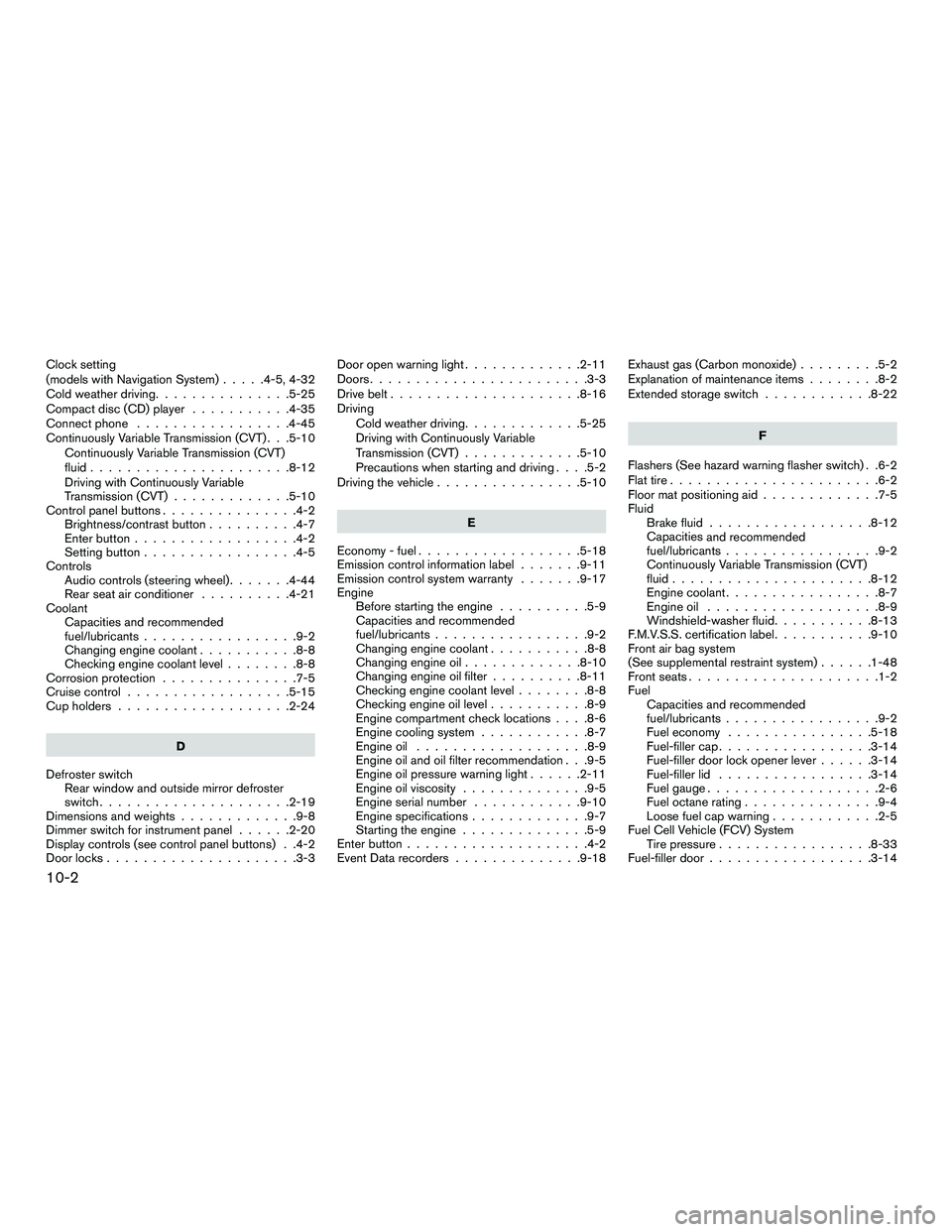
Clock setting
(models with Navigation System).....4-5,4-32
Cold weather driving ...............5-25
Compact disc (CD) player ...........4-35
Connect phone .................4-45
Continuously Variable Transmission (CVT) . . .5-10 Continuously Variable Transmission (CVT)
fluid ......................8-12
Driving with Continuously Variable
Transmission (CVT) .............5-10
Control panel buttons ...............4-2
Brightness/contrast button ..........4-7
Enterbutton..................4-2
Setting button .................4-5
Controls Audiocontrols(steeringwheel).......4-44
Rear seat air conditioner ..........4-21
Coolant Capacities and recommended
fuel/lubricants .................9-2
Changing engine coolant ...........8-8
Checking engine coolant level ........8-8
Corrosionprotection ...............7-5
Cruisecontrol..................5-15
Cupholders...................2-24
D
Defroster switch Rear window and outside mirror defroster
switch.....................2-19
Dimensionsandweights.............9-8
Dimmer switch for instrument panel ......2-20
Display controls (see control panel buttons) . .4-2
Door locks .....................3-3 Door open warning light
.............2-11
Doors ........................3-3
Drive belt .....................8-16
Driving Cold weather driving .............5-25
Driving with Continuously Variable
Transmission (CVT) .............5-10
Precautions when starting and driving ....5-2
Driving the vehicle ................5-10
E
Economy - fuel ..................5-18
Emission control information label .......9-11
Emission control system warranty .......9-17
Engine Before starting the engine ..........5-9
Capacities and recommended
fuel/lubricants .................9-2
Changingenginecoolant...........8-8
Changingengineoil.............8-10
Changing engine oil filter ..........8-11
Checking engine coolant level ........8-8
Checking engine oil level ...........8-9
Engine compartment check locations ....8-6
Engine cooling system ............8-7
Engineoil ...................8-9
Engine oil and oil filter recommendation . . .9-5
Engine oil pressure warning light ......2-11
Engine oil viscosity ..............9-5
Engine serial number ............9-10
Engine specifications .............9-7
Starting the engine ..............5-9
Enterbutton....................4-2
EventDatarecorders..............9-18 Exhaust gas (Carbon monoxide)
.........5-2
Explanation of maintenance items ........8-2
Extended storage switch ............8-22
F
Flashers (See hazard warning flasher switch) . .6-2
Flat tire .......................6-2
Floor mat positioning aid .............7-5
Fluid Brake fluid ..................8-12
Capacities
and recommended
fuel/lubricants.................9-2
Continuously Variable Transmission (CVT)
fluid......................8-12
Enginecoolant.................8-7
Engineoil ...................8-9
Windshield-washer fluid ...........8-13
F.M.V.S.S. certification label ...........9-10
Front air bag system
(See supplemental restraint system) ......1-48
Frontseats.....................1-2
Fuel Capacities and recommended
fuel/lubricants.................9-2
Fuel economy ................5-18
Fuel-filler cap .................3-14
Fuel-filler door lock opener lever ......3-14
Fuel-filler lid .................3-14
Fuelgauge...................2-6
Fuel octane rating ...............9-4
Loose fuel cap warning ............2-5
Fuel Cell Vehicle (FCV) System Tire pressure .................8-33
Fuel-filler door ..................3-14
10-2
Page 309 of 312
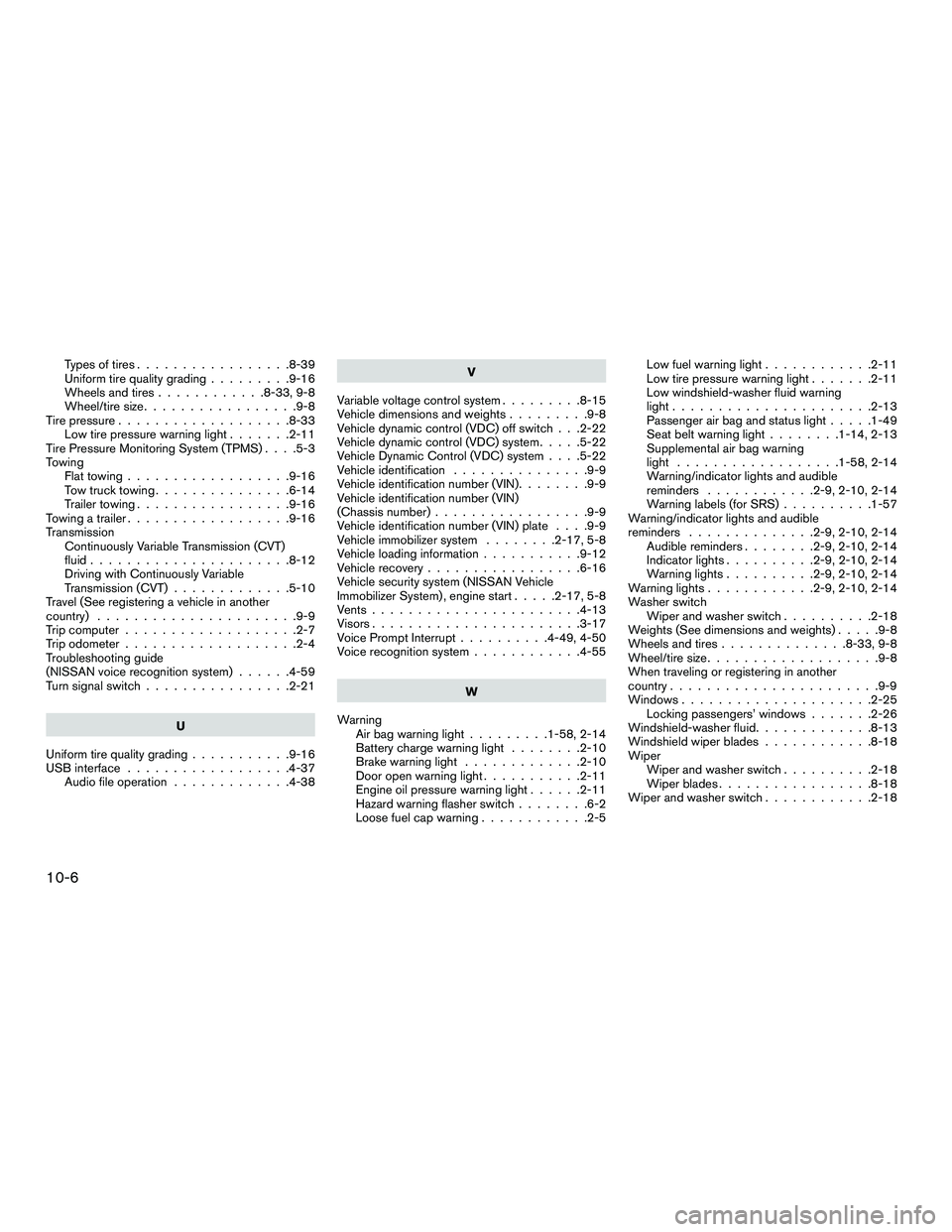
Types of tires.................8-39
Uniform tire quality grading .........9-16
Wheels and tires ............8-33,9-8
Wheel/tire size .................9-8
Tirepressure...................8-33 Low tire pressure warning light .......2-11
Tire Pressure Monitoring System (TPMS) ....5-3
Towing Flattowing..................9-16
Towtrucktowing...............6-14
Trailertowing.................9-16
Towing a trailer ..................9-16
Transmission Continuously Variable Transmission (CVT)
fluid ......................8-12
Driving with Continuously Variable
Transmission (CVT) .............5-10
Travel (See registering a vehicle in another
country) ......................9-9
Trip computer ...................2-7
Trip odometer ...................2-4
Troubleshooting guide
(NISSAN voice recognition system) ......4-59
Turnsignalswitch................2-21
U
Uniform tire quality grading ...........9-16
USB interface ..................4-37
Audio file operation .............4-38 V
Variable voltage control system .........8-15
Vehicle dimensions and weights .........9-8
Vehicle dynamic control (VDC) off switch . . .2-22
Vehicle dynamic control (VDC) system .....5-22
Vehicle Dynamic Control (VDC) system ....5-22
Vehicle identification ...............9-9
Vehicle identification number (VIN) ........9-9
Vehicle identification number (VIN)
(Chassis number) .................9-9
Vehicle identification number (VIN) plate ....9-9
Vehicle immobilizer system ........2-17,5-8
Vehicle loading information ...........9-12
Vehicle recovery .................6-16
Vehicle security system (NISSAN Vehicle
Immobilizer System) , engine start .....2-17,5-8
Vents.......................4-13
Visors.......................3-17
Voice Prompt Interrupt ..........4-49,4-50
Voice recognition system ............4-55
W
Warning Air bag warning light .........1-58,2-14
Battery charge warning light ........2-10
Brake warning light .............2-10
Door open warning light ...........2-11
Engine oil pressure warning light ......2-11
Hazard warning flasher switch ........6-2
Loose fuel cap warning ............2-5 Low fuel warning light
............2-11
Low tire pressure warning light .......2-11
Low windshield-washer fluid warning
light......................2-13
Passenger air bag and status light .....1-49
Seat belt warning light ........1-14,2-13
Supplemental air bag warning
light ..................1-58,2-14
Warning/indicator lights and audible
reminders ............2-9,2-10,2-14
Warning labels (for SRS) ..........1-57
Warning/indicator lights and audible
reminders ..............2-9,2-10,2-14
Audible reminders ........2-9,2-10,2-14
Indicatorlights..........2-9,2-10,2-14
Warninglights..........2-9,2-10,2-14
Warninglights............2-9,2-10,2-14
Washer switch Wiper
and washer switch ..........2-18
Weights(Seedimensionsandweights).....9-8
Wheels and tires ..............8-33,9-8
Wheel/tire size ...................9-8
When traveling or registering in another
country .......................9-9
Windows .....................2-25
Locking passengers’ windows .......2-26
Windshield-washer fluid .............8-13
Windshield wiper blades ............8-18
Wiper Wiper and washer switch ..........2-18
Wiperblades.................8-18
Wiper and washer switch ............2-18
10-6